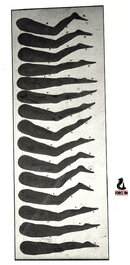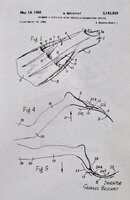Right... if your goal is to cover ground quickly there are better kicks.
You're arguing a point that no one is making.
RJP, I was not trying to quibble with you...Sorry if it seemed that way...this is a major rant topic for me. I can't help myself..

Perhaps because I dive mostly South Florida, with occasional trips to OTHER HIGH CURRENT locations like Fiji...Diving to me, is very connected to being efficient in any current from zero to 6 mph ( we actually have inlet dives like this). While few people need to deal with more than 3 mph, even at this speed, the fin choice, and the fin kicks used...and the proper kick shape for each will have a major effect on whether the diver enjoys the more challenging current dives, or not. Having some background in white water kayaking type understanding of where water flows when it hits objects at various angles, is also a huge benefit on high current shipwrecks.
It blows my mind how so many in the industry, like to say that you only need to swim slow...and that is all there is...
This is fine for a novice in a still water location, but I think "advanced divers" should have skills for currents also. That means efficiency...the issue in the previous post....has to also include efficiency in currents. Which will not eliminate frog kicks, but it will require several OTHER kicks to be well developed. It will also show fins like Scuba Pro Jetfins, to be poor for the flutter or dolphin kick, except in a 10 second sprint....The jets have poor efficiency when you need to maintain a hi pace flutter for a minute or considerably longer to get where you need to go. But the jets are awesome for low speed frog kick.
---------- Post added September 22nd, 2015 at 02:32 PM ----------
Thank you, Dan. Before making my first fin design, I drew out the leg's kicking movement, ( 1971). When you review the foot inside a " Shoe Fin ", you can see why a Frog Kick might make sense. I logged many hours 1966-1980, woking in these fin's and Frog Kicking broke up the pain from a flutter kick on my TOES.
View attachment 216869View attachment 216870
Hi Bob,
That's actually a good chart for many new divers to see.
Far too many, never extend their foot..the toe pointing portion....their Dive instructors don't see it, or address it....and when they do the kicks with the foot staying bent, they are horribly inefficient, and look like they are bicycling ( but like the worst kind of bicyclist...like the drunks with $25 clunkers carrying all their belongings on the bike)
The nasty split fins I dislike so much, are so floppy that even without correct toe pointing, they still create some push...Force Fins would be easier for them to learn with, as the results of doing the kick close to correct, are immediately gratifying....they move fast and easily, all of a sudden. Stick freedive fins on these novices that try to kick without any ankle articulation, and they would be unable to move at all....a complete fail.
[video=youtube;2VEthluthE4]https://www.youtube.com/watch?v=2VEthluthE4&[/video]
The typical instructor will see this, and just tell the novice he is bicycle kicking....he is pushing in a line like doing a squat with one leg.
The clueless novice "thinks" this is the right thing to do, because he is "pushing" against this big fin, and there is some forward propulsion this generates.
A better instructor, would notice that the toes never point, and without pointing, there will be no flutter kick --the diver would feel that fluttering with flat feet( at 90 degree bend like in standing) , would use none of the fin...they don't make the connection to toe pointing and the flutter motion....Or...they have no flexibility in their ankles, so cant articulate this way...or maybe have no strength like this....in any case, only nasty fins like split fins, work for this kind of diver.....
A good diver, with good coordination for kick shape, can get much more out of any good fin....particularly Force Fins








